Paris is the capital and most populous city of France. Since the 17th century, Paris has been one of Europe’s major centres of finance, diplomacy, commerce, fashion, science, and the arts. According to the Economist Intelligence Unit Worldwide Cost of Living Survey in 2018, Paris was the second most expensive city in the world, after Singapore, and ahead of Zürich, Hong Kong, Oslo and Geneva. Another source ranked Paris as most expensive, on a par with Singapore and Hong Kong, in 2018. All these elements help to bring the increasing price of real estate in Paris. In this blog, I’ll talk about the second-hand apartments purchases in Paris between January 2014 and June 2019, with the following points:
- Data description
- How large are the apartments?
- Which is the most expensive district?
- Relationship between area & apartment price?
- Price evolution in terms of timing?
Data description
First of all, I downloaded real estate transactions’ data here. In the dataset, we have transaction’s information from January 2014 to June 2019, like “id_mutation” to identify the transaction, “nature_mutation” specifies the sale’s nature, “nombre_pieces_principales” indicates the number of rooms, “valeur_fonciere” presents the sold price, “code_commune”, “nom_commune” and “code_departement” specify the communities and departments, “surface_reelle_bati” describes the real surface area, longitude and latitude can help us to determine the location.
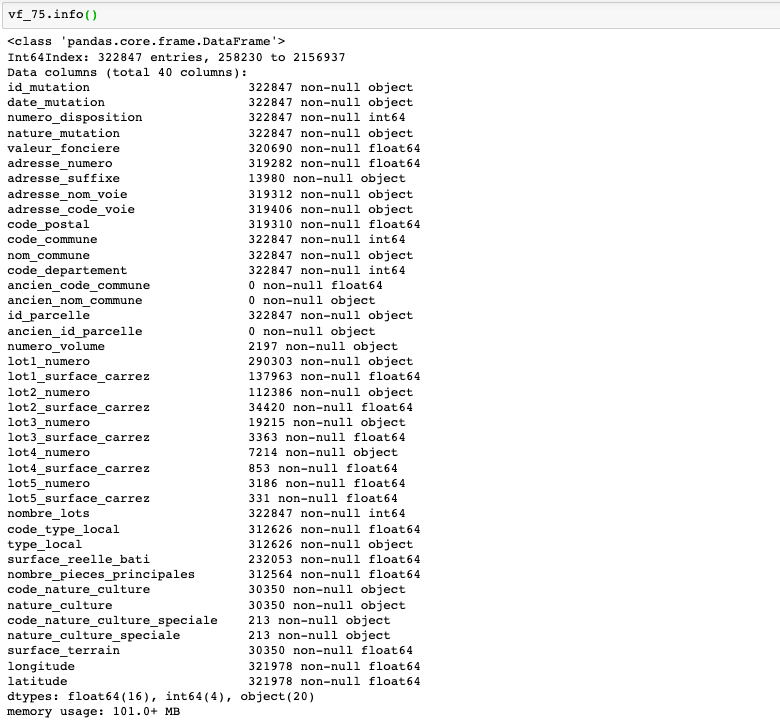
For this analysis, I only took account of second-hand apartments’ transactions with positive area in Paris.
How large are the apartments?
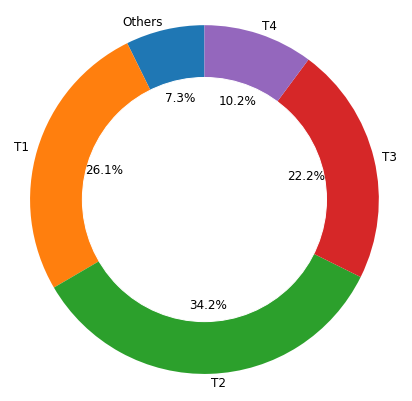
I classed apartments into 5 groups in terms of rooms’ amount: T1, which means one-room apartment with around 23 m2; T2, which means two-room apartment with around 40 m2; T3 presents three-room apartment around 63 m2; T4 are four-room apartments nearly 93 m2; T5 are five-room apartments with larger area about 147 m2. This donut chart describes the quote-part of different pieces’ apartment among the transactions. T1 and T2 hold 60% transactions, 22% transactions sold T3 apartments, other purchases are for larger apartments. Let’s go further on the details.
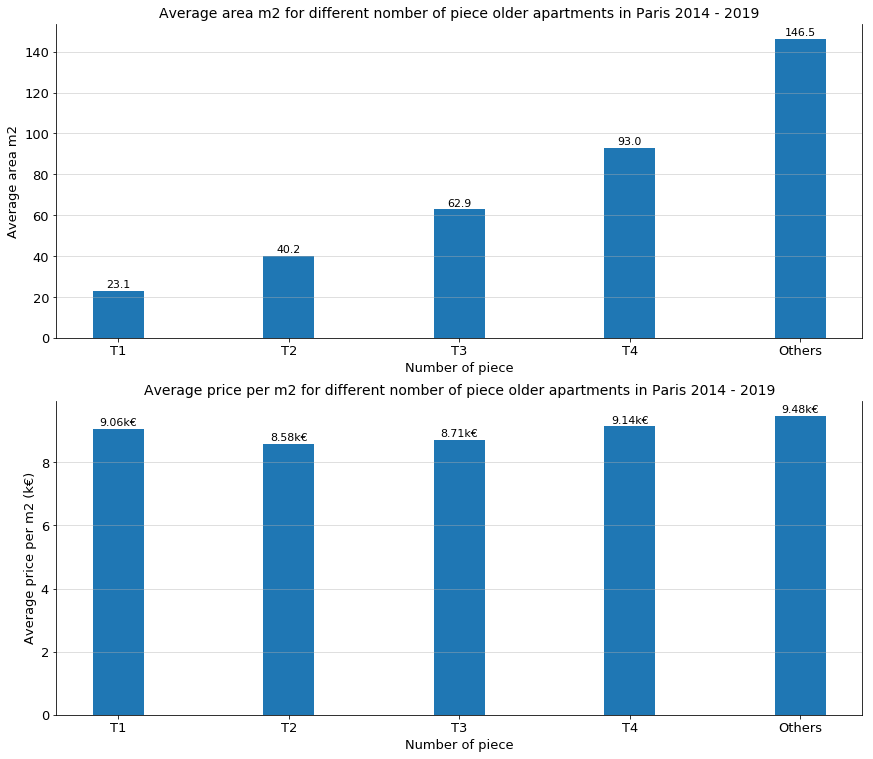
This graph describes the average price m2 for different number of pieces second-hand apartments in Paris, between January 2014 and June 2019. According to the second graph, we find that although T2 and T3 are much larger than T1, their unit prices are 5.5% and 4% lower than the unit price of T1. Moreover, average area of T4 is three times larger than T1, its unit price is only 1% more expensive than T1; similar for other piece-nomber apartments. Why are T1 apartments that expensive per m2? That might be because there are many students or young workers in Paris, they need to rent a big enough apartment, which makes investors to invest T1 apartments, it also leads to higher demands on T1.
Which is the most expensive district?

According to this map, we observe that the second-hand apartments in districts 1, 4, 6, 7 and 8 are much more expensive than other districts, their average unit price is at least 11000 euros; on the contrary, the second-hand apartments in districts 13, 18, 19 and 20 are much cheaper than others, their average unit price is less than 8k euros. This might be caused by geographical positions, number of pieces, apartment’s state, performance of energy, public security, etc. The public transport in the city center is more than other areas, there are also lots of shopping centers or tourist spots, which attracts a great deal of people, so that make the city center to be more valuable.
Furthermore, according to the stacked bar plot below, it’s obvious that there are much more transactions in the 18th district than other areas, more than 50% sold apartment are 2-room or 3-room apartments, that’s one of the reasons why the unit price of 18th district is cheaper, same for 19th and 20th district; for the districts as 1st, 4th or 5th district, nearly one third of sold apartments are T1 apartments, which might be one of the reasons why the unit price of these districts is more expensive.
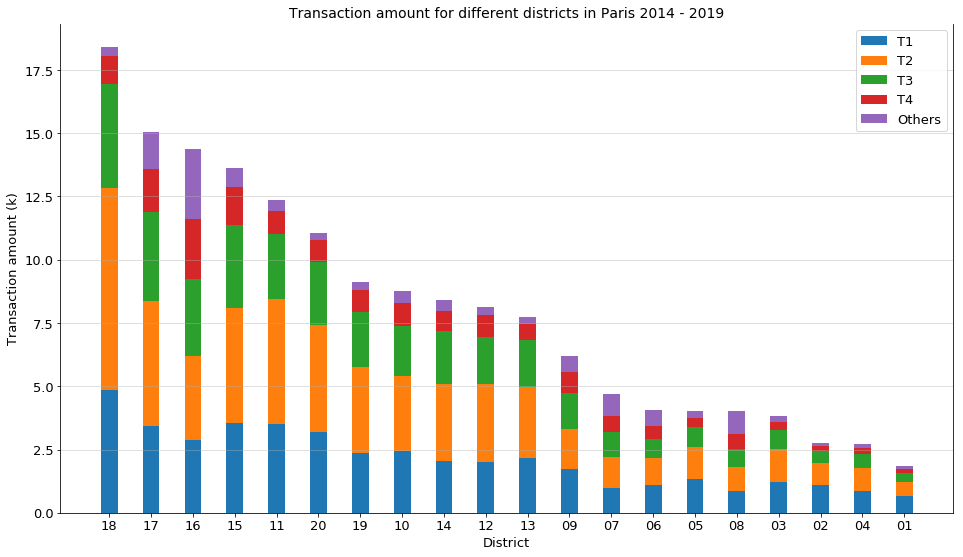
Relationship between area & apartment price?
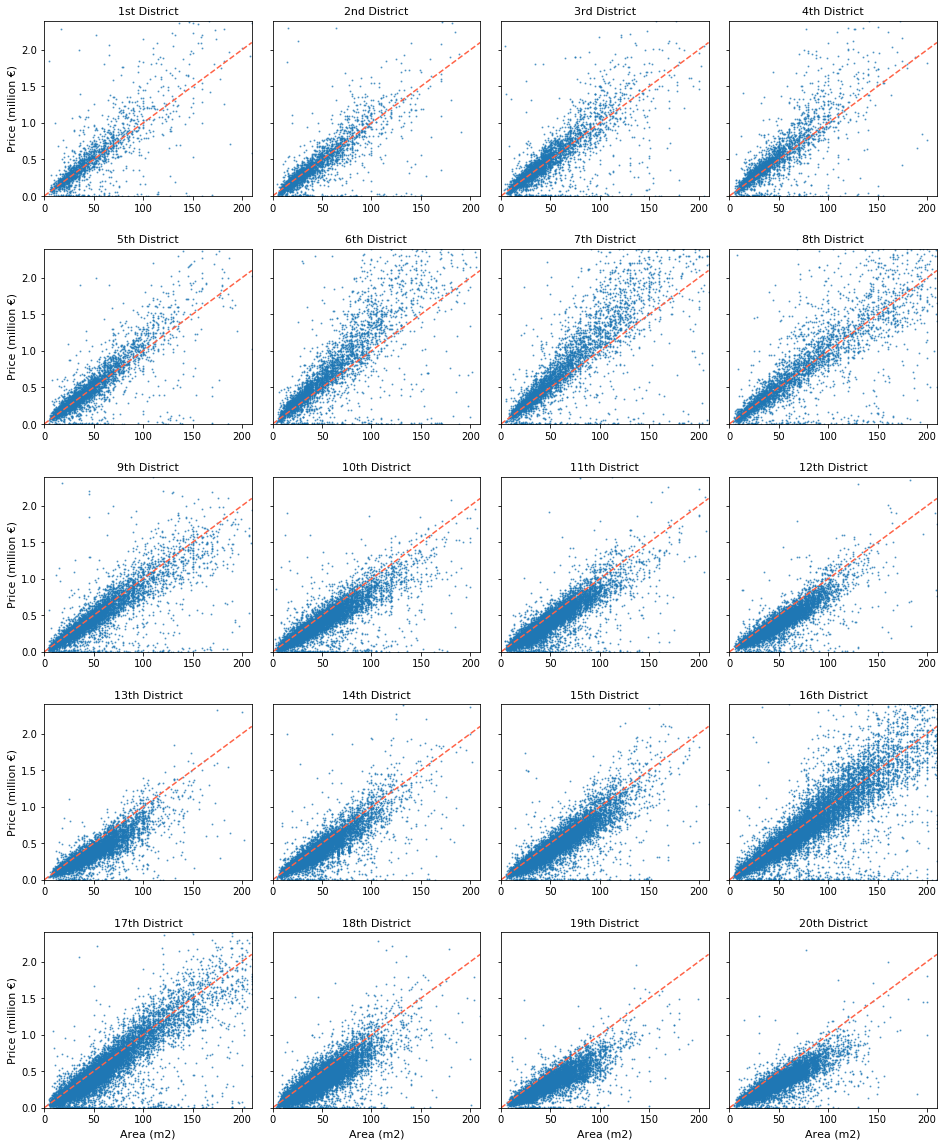
According to this group of scatter plots, we can simply get the relationship between second-hand apartments’ price and their area. Each point stands for one transaction, the plots on the red dash line mean that the price per m2 of these transactions is 10k euros. The points above the dash line indicate their unit price are greater than 10k euros; otherwise, it’s less than 10k euros per m2.
For the 1st, 2nd and 4th district, almost sold apartments are smaller than 50 m2, but their price varies widely to nearly 2 million euros; for the 8th, 16th and 17th district, almost sold apartments’ price also arrive more than 2 million euros, but their area varies widely to 200 m2; moreover, there are also apartments whose unit price and area don’t vary that widely, as in 13th, 18th, 19th and 20th district, most of the apartments here are smaller than 100 m2 and cheaper than 1 million euros, so than less than 10k euros per m2.
Price evolution in terms of timing?

This graph describes second-hand apartments’ transaction amount and average price per m2 of Paris, between January 2014 and June 2019. The orange line shows the monthly average price per m2, the blue area displays the monthly transaction amount. During 5.5 years, the average price per m2 increases 32% (10.3/7.8 - 1), especially from the year 2017, the average price per m2 increases nearly 20% (10.3/8.6 - 1). Moreover, the transaction amount arrives the yearly lowest point in August, which might because people go on holiday at that time; on the contrary, the transactions in July or September are higher than other months, which means that people usually sign the purchase promise in May or July (supposed that we have 2 months for negotiating the credit between the purchase promise and purchase agreement), so that they can sign the agreement before their holiday or before the school opening.
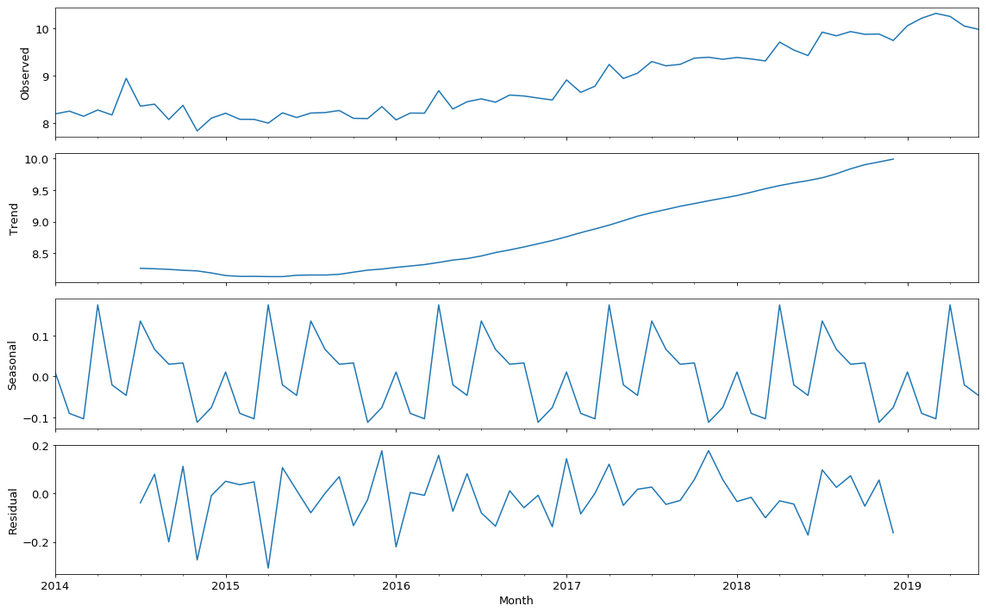
Then I used Time Series additive model to decompose data into a trend
component, a seasonal component and a residual component. The trend component
captures changes over time, the seasonal component captures cyclical effects
due to the time of year, the residual component captures the influences not
described by the trend and seasonal effects. Thanks to this model, we find that
except for July, there are another transaction peak in April, which we didn’t
find above. In March and November, the transactions arrive at their low points,
that might be because during the transition period between 2 years, the desire
for purchasing or selling apartments is not that high.

Moreover, I used fbprophet module to predict the price per m2. The blacks
points present actual values, the blue line indicates the forecasted values,
and the light blue shaded region is the uncertainty. The uncertainty’s region
increases for the prediction because of the initial uncertainty and it grows
over time. This can be impacted by policy, social elements, or some others.
Conclusion
According to this analysis, we find that among all transactions of second-hand apartments in Paris, T1 and T2 hold 60% transactions. The second-hand apartments in districts 1, 4, 6, 7 and 8 are much more expensive than other districts, their average unit price is at least 11000 euros; on the contrary, the second-hand apartments in districts 13, 18, 19 and 20 are much cheaper than others, their average unit price is less than 8k euros.
You can find all codes in this notebook.
Reference
- DGFiP, “Demandes de valeurs foncières géolocalisées”, data.gouv.fr. [Online]. Available: https://www.data.gouv.fr/fr/datasets/demandes-de-valeurs-foncieres-geolocalisees/
- Grégoire David, “Departments polygon”, github.com. [Online]. Available: https://github.com/gregoiredavid/france-geojson/blob/master/departements.geojson
- APUR, “APUR : Communes - Ile de France”, data.gouv.fr. [Online]. Available: https://www.data.gouv.fr/fr/datasets/apur-communes-ile-de-france/
- “Paris”, en.wikipedia.org. [Online]. Available: https://en.wikipedia.org/wiki/Paris
- Ehi Aigiomawu, “Analyzing time series data in Pandas”, towardsdatascience.com. [Online]. Available: https://towardsdatascience.com/analyzing-time-series-data-in-pandas-be3887fdd621
- Will Koehrsen, “Time Series Analysis in Python: An Introduction”, towardsdatascience.com. [Online]. Available: https://towardsdatascience.com/time-series-analysis-in-python-an-introduction-70d5a5b1d52a
- Walkerssk, “Paris France Eiffel tower night”, pixabay.com. [Online]. Available: https://pixabay.com/photos/paris-france-eiffel-tower-night-1836415/